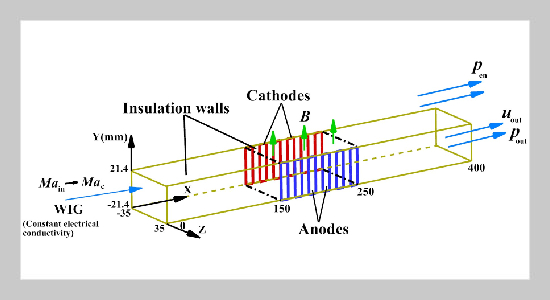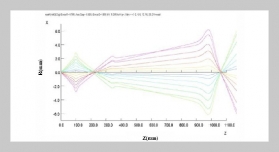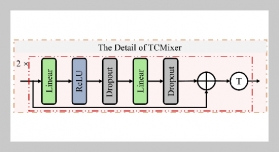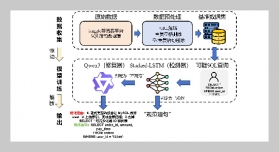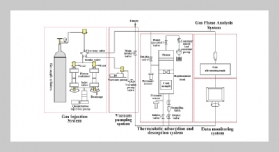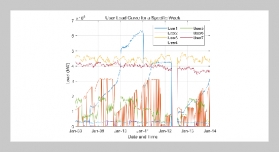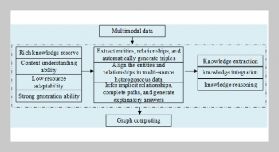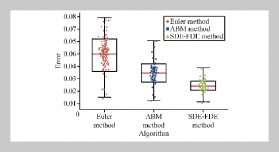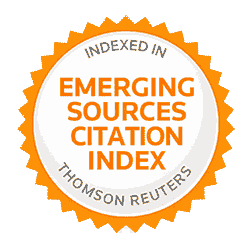- [1] Y. Tamada, N. Niwa, T. Takahashi, T. Fujino, and M. Ishikawa. “Influence of Cross-Sectional Shape on Generator Performance and Electromagnetic Fluid Phenomena of DCW-MHD Generators for Hyper sonic Airplanes”. In: 44th AIAA Plasmadynamics and Lasers Conference. 2013, 2891. DOI: 10.2514/6.2013-2891.
- [2] S. Khalili, A. J. Dehkordi, and M. H. Giahi, (2015) “Investigating the Effect of Channel Angle of a Subsonic MHD (Magneto-Hydro-Dynamic) Generator on Opti mumEfficiency of a Triple Combined Cycle" Energy 85: 543–555. DOI: 10.1016/j.energy.2015.03.064.
- [3] M.Tanaka,Y.Zhuang,F.Komatsu,T.Murakami,and Y. Okuno. “Experiments of High Temperature Inert Gas Plasma MHDPowerGeneration with a Faraday Type Generator”. In: 44th AIAA Plasmadynamics and Lasers Conference. 2013, 2889. DOI: 10.2514/6.2013-2889.
- [4] P. Yang, B. Zhang, Y. Li, Y. Wang, C. Duan, H. Fan, and L. Gao, (2016) “Investigation of MHD Power Gen eration with Supersonic Non-equilibrium RF Discharge" Chinese Journal of Aeronautics 29(4): 855–862. DOI: 10.1016/j.cja.2016.06.018.
- [5] C.Lee andH.Lu. “Quasi-one-dimensional Paramet ric Study for MHDGenerator in MHDBypassScram jet System”. In: 45th AIAA Aerospace Sciences Meeting and Exhibit. 2008, 644. DOI: 10.2514/6.2007-644.
- [6] H. LI, H. HUANG, Y. ZHANG, and C. LIU, (2023) “Numerical Investigation for Performance of MHD Gener ator in Hypersonic Vehicle Nozzle" Journal of Propul sion Technology 44(8): 160–172. DOI: 10.13675/j.cnki.tjjs.210790.
- [7] H.Yousefi, M. Mahmoudi, and M. H. Ghodusinejad, (2024) “Modeling and Sensitivity Analysis of a Super sonic Inductive Magnetohydrodynamic (MHD) Genera tor" Future Technology 3(2): 1–10. DOI: 10.55670/fpll.futech.3.2.1.
- [8] J. Zhang, J. LI, Z. Zhang, and Z. WEI, (2022) “Numer ical Analysis of Deflection Control of a Gas Plasma Jet Based on Magnetohydrodynamic Staggered Electrode Con f iguration" Chinese Journal of Aeronautics 35(12): 47–58. DOI: 10.1016/j.cja.2022.04.010.
- [9] H.Li, P. Lu, H. Huang, Y. Zhang, and C. Liu, (2023) “Effects of Cesium Salts on the Electrical Conductivity of the Weakly Ionized Gas in a Hypersonic MHD Channel" International Journal of Aeronautical and Space Sciences 24(5): 1171–1186. DOI: 10.1007/s42405-023-00592-6.
- [10] F. Liu and A. Zhu, (2023) “Thermodynamic Analysis of Nuclear Closed Cycle MHD Space Power System" Progress in Nuclear Energy 162: 104755. DOI: 10.1016/j.pnucene.2023.104755.
- [11] M. Babaelahi and S. Sadri, (2024) “Magneto-Hydro Dynamic Generator with Joule Heating and Viscous Dis sipation: An Analytic Investigation of Mixed Convection Flow" Arabian Journal for Science and Engineering 49: 11445–11455. DOI: 10.1007/s13369-023-08693-w.
- [12] K. Ork and Y. Okuno, (2023) “Numerical Study of Plasma Behavior and Power Generation Characteristics in a Disk MHDGenerator With Xenon-Seeded Neon Gas" IEEE Transactions on Plasma Science 51(6): 1518 1526. DOI: 10.1109/tps.2023.3271952.
- [13] K. Zhang, Y. Zhao, Q. Wang, J. Li, F. Zeng, and C. Yan, (2022) “Uncertainty Analysis and Calibration of SST Turbulence Model for Free Shear Layer in Cavity Ramp Flow" Acta Astronautica 192: 168–181. DOI: 10.1016/j.actaastro.2021.12.027.
- [14] S. Mozaffari, S.-G. Cai, J. Jacob, and P. Sagaut, (2024) “Lattice Boltzmann k-ω SST Based Hybrid RANS/LES Simulations of Turbulent Flows" Journal of Computa tional Physics 514: 113269. DOI: 10.1016/j.jcp.2024.113269.
- [15] Z.Lu,X.Zhang,J.Li,andH.Ma,(2023)“Experimental Study on Inert Gas Magnetohydrodynamic Power Gener ation by Detonation-Driven" Chinese Journal of The oretical and Applied Mechanics 55(4): 1019–1027. DOI: 10.6052/0459-1879-22-576.
- [16] H.Xiao, X. Ke, A. Oloruntoba, Z. Huang, Y. Zhang, and C. Liu, (2024) “Investigating Choking Phenomena in CFB Risers Under Different Operating Parameters" Powder Technology 440: 119752. DOI: 10.1016/j.powtec.2024.119752.
- [17] J. Chen, M. Sun, P. Li, B. An, M. Li, Y. Yao, T. Wang, and J. Wang, (2024) “Numerical and Experimental Study of Choking Phenomenon on RBCC Engines in Ejec tor Mode" Aerospace Science and Technology 146: 108922. DOI: 10.1016/j.ast.2024.108922.
- [18] A.K.FlockandA.Gülhan,(2015)“ExperimentalInves tigation of the Starting Behavior of a Three-Dimensional Scramjet Intake" AIAA Journal 53(9): 2686–2693. DOI: 10.2514/1.J053786.
- [19] A. K. Flock and A. Gülhan, (2019) “Modified Kantrowitz Starting Criteria for Mixed Compression Su personic Intakes" AIAA Journal 57(5): 2011–2016. DOI: 10.2514/1.J057283.
- [20] E. Timofeev, R. Tahir, and S. Molder. “On Recent De velopments Related to Flow Starting in Hypersonic Air Intakes”. In: 15th AIAA International Space Planes and Hypersonic Systems and Technologies Conference. 2008, 2512. DOI: 10.2514/6.2008-2512.
- [21] L. Shi, D. Gao, L. Xing, F. Qin, and G. He, (2020) “Numerical Study on Thermal Choke Behaviors Driven by Various Rocket Operations in an RBCC Engine in Ramjet Mode" International Journal of Turbo & Jet-Engines 37(3): 305–317. DOI: 10.1515/tjj-2019-0012.
- [22] F. Chen, (2016) “Performance Analysis for Ideal Faraday Type Magnetohydrodynamic (MHD) Channel" Interna tional Journal of Fluid Dynamics 4(3): 43–53. DOI: 10.12677/ijfd.2016.43006.
- [23] G. Gao, D. Li, J. Gou, C. Gong, and S. Li, (2022) “A Study of Interfacial Electrical Contact Resistances of Ther moelectric Generators For Hypersonic Vehicles by Exper imental Measurements and Two-scale Numerical Sim ulations" Aerospace Science and Technology 131: 107966. DOI: 10.1016/j.ast.2022.107966.
- [24] C. Jiang, T. Wang, S. Zhu, G. Yu, Z. Wu, and E. Luo, (2023) “A Method to Optimize the External Magnetic Field to Suppress the End Current in Liquid Metal Magne tohydrodynamic Generators" Energy 282: 128251. DOI: 10.1016/j.energy.2023.128251.
- [25] Y. Inui and M. Ishikawa, (2002) “Power Inversion and Control of Closed Cycle Disk MHD Generator Using Cur rent Source PWM Inverter" Energy conversion and management 43(5): 721–732. DOI: 10.1016/s0196 8904(01)00038-3.
- [26] W. Yao, (2022) “Nonequilibrium Effects in Hypersonic Combustion Modeling" Journal of Propulsion and Power 38(4): 523–540. DOI: 10.2514/1.B38617.
- [27] X. Xu, M. Salauddin, and J. Keenahan. “A Conver gence Study Simulating Regular Waves Using the k-ω SST Turbulence Model in OpenFOAM”. In: IOP Conference Series: Materials Science and Engineering. 1312. 1. 2024, 012006. DOI: 10.1088/1757-899X/1312/1/012006.
- [28] S. Younoussi and A. Ettaouil, (2024) “Calibration Method of the k-ω SST Turbulence Model for Wind Tur bine Performance Prediction Near Stall Condition" He liyon 10(1): 1–11. DOI: 10.1088/1757-899X/1312/1/012006.
- [29] S. Ogawa, K. Kobayashi, and S. Tomioka, (2024) “Forced Ignition Modeling of Methane-Ethylene Mixtures in Scramjet Combustors" Combustion and Flame 263: 113383. DOI: 10.1016/j.combustflame.2024.113383.
- [30] Y. Wang, K. Cheng, J. Xu, W. Jing, H. Huang, and J. Qin, (2024) “A Rapid Performance Prediction Method for Two-Phase Liquid Metal MHD Generators Based on Quasi-One-Dimensional Model" Thermal Science and Engineering Progress 47: 102258. DOI: 10.1016/j.tsep.2023.102258.
- [31] H. Huang, L. Li, G. Zhu, and L. Li, (2018) “Perfor mance Investigation of Plasma Magnetohydrodynamic PowerGenerator" AppliedMathematicsandMechan ics 39: 423–436. DOI: 10.1007/s10483-018-2310-9.
- [32] X. Zheng, H. Lu, D. Xu, and G. Cai, (2011) “Numeri cal Simulation of 2D Supersonic Magnetohydrodynamic Channel and Study on Hall Effect" Chinese Journal of Aeronautics 24(2): 136–144. DOI: 10.1016/S1000-9361(11)60017-4.
- [33] D. Cross, B. Hughes, D. Ingham, and L. Ma, (2015) “AValidated NumericalInvestigation of the Effects of High Blockage Ratio and Train and Tunnel Length Upon Un derground Railway Aerodynamics" Journal of Wind Engineering and Industrial Aerodynamics 146: 195 206. DOI: 10.1016/j.jweia.2015.09.004.
- [34] N.BaranwalandS.P.Mahulikar,(2016) “IR Signature Study of Aircraft Engine for Variation in Nozzle Exit Area" Infrared Physics & Technology 74: 21–27. DOI: 10.1016/j.infrared.2015.11.001.
- [35] O.Lamberts, P. Chatelain, and Y. Bartosiewicz, (2018) “Numerical and Experimental Evidence of the Fabri choking in a Supersonic Ejector" International Journal of Heat and Fluid Flow 69: 194–209. DOI: 10.1016/j.ijheatfluidflow.2018.01.002.
- [36] M.Bizzozero, Y. Sato, and M. A. Sayed, (2021) “Aero dynamic Study of a Hyperloop Pod Equipped with Com pressor to Overcome the Kantrowitz Limit" Journal of Wind Engineering and Industrial Aerodynamics 218: 104784. DOI: 10.1016/j.jweia.2021.104784.
- [37] S. R. Gupta, J. A. Taylor, and T. Krupenkin, (2022) “Theoretical Investigation of a Novel Three-phase Alternat ing Current Liquid Metal Vortex Magnetohydrodynamic Generator" Sustainable Energy Technologies and Assessments 53: 102436. DOI: 10.1016/j.seta.2022.102436.


